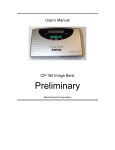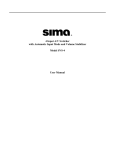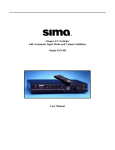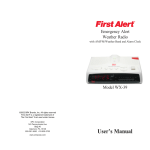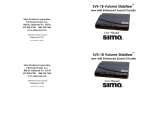Download Sima CP-150 User`s manual
Transcript
User’s Manual CP-150 Image Bank Sima Products Corporation Image Bank CP-150 Introduction Preface About this manual This manual is designed to make using the CP-150 Smart Remote Control as easy as possible. Information in this document has been carefully checked for accuracy; however, no guarantee is given to the correctness of the contents. The information in this document is subject to change without notice. © Copyright 2001 This document contains proprietary information protected by copyright. All rights are reserved. No part of this manual may be reproduced by any mechanical, electronic or other means, in any form, without prior written permission of Sima Products Corp. Trademarks- all trademarks and registered trademarks are the property of their respective owners. FCC Rules & Warning This device complies with Part 15 of the FCC Rules. Operation is subject to the following two conditions: (1) This device may not cause harmful interference; and (2) This device must accept any interference received including interference, which may cause undesired operation. Changes or modifications not expressly approved by the party responsible for compliance could void the user’s authority to operate the equipment. Legal Warning 1. Some copying may require the permission of the relevant copyright owner. We do not have the authority to grant any such permission. 2. The company assumes no responsibility to the contents stored in the internal hard disk. Maintenance Clean the Image Bank with a soft slightly dampened lint-free cloth. Do not use any cleaning agents as they may have a corrosive effect. Do not expose the Image Bank to humidity, rain, direct sunlight or excessive heat. Sima Products Corp. 140 Pennsylvania Ave. Bldg. # 5 Oakmont, PA 15139 800-345-7462 412-828-3700 412-828-3775 FAX www.simacorp.com Image Bank CP-150 User Manual Version 1.0 1 2 P/N 21633 rev. 20017 Image Bank CP-150 Introduction Introducing the CP-150 Congratulations on your purchase of the Sima Image Bank CP-150. The CP-150 is a portable image storage device equipped with a hard drive, which can store images taken with a digital camera. It is compatible with SM or CF memory cards. With the Image Bank, you can easily transfer image files from your camera memory cards to the hard drive, allowing you to re-use the memory cards. Also, using the USB interface, you can transfer image files between the Image Bank and your PC or Macintosh computer. Convenient and easy to use, the CP-150 provides you with a portable image storage solution. This manual will help you learn how to use all the features of the CP-150. It will not explain how to use the functions for your digital camera. Please refer to your camera’s user manual for information related to it. 3 Image Bank Introduction Overview 1. 2. 3. 4. 5. 6. 7. 8. 9. 10. 11. 12. The bottom cover The top cover. LCD display panel Ready LED Busy LED CF copy button Power on/off & partition selector (P.S. key). SM card copy button Slot for CF card (Type I, Type II, and Microdrive) Slot for SM card. The input for USB adapter cable. Power supply input Figure 1. The CP-150 comes with a portable battery pack and a carrying case for convenience and flexibility. The battery pack and CP-150 fit into the carrying case as shown in figure 1A at right. Figure 1A 4 Image Bank Introduction Accessories The Image Bank CP-150 comes with the following accessories: • Image Bank • User’s Manual (this document) • 12V Power cord • • 120VAC to 12V DC adapter USB adapter cable • Portable battery pack • Carrying case Important Note: The Image Bank CP-150 stores pictures in a digital format. As with all such stored files, damage to the unit’s hard drive may result in the permanent loss of your pictures. While picture files can be stored in the CP-150 indefinitely, we strongly recommend that you transfer and back up your picture files as soon as possible to avoid losing valuable pictures. The following tips may help you retain your pictures: • • • Avoid dropping, banging or hitting the CP-150 unit. Do not immerse the unit in water or expose it to moisture, dirt, sand extreme heat/cold, magnetic interference or other extreme conditions. Make sure you are familiar with the CP-150 - complete the entire file transfer sequence successfully at least once - before erasing photos from your SM or CF cards. Power options: 115VAC 12V cigarette plug Portable Battery pack 1. Plug base unit into 120VAC outlet 2. Plug cord with cigarette lighter adapter into base unit. 3. Plug into CP-150 1. Plug 12V adapter into car/truck cigarette lighter 2. Plug adapter into CP-150 1. Insert 6 AA alkaline batteries into battery pack. 2. Insert Battery pack into case. 3. Plug battery pack into CP150 Note: The AC/DC converter supports 100-240 VAC 50-60 Hz 5 Image Bank Copy pictures to CP-150 To transfer pictures from your CF and SM FLASH cards into the Image Bank’s internal hard drive follow the steps below: 1. Plug the power cord into the jack located on the side of the Image Bank. Note: Use only the power cord, battery pack or adapters supplied with the CP-15 2. Insert memory cards. With the CP-150 in the off mode, insert either a SmartMedia card in the appropriate slot (on the left) or a CompactFlash card in the appropriate slot (on the right.) or The corresponding icon will appear in the display window. See Figure 1 at right Important Note: The contact pads of a SmartMedia card must face down when you insert it into Image Bank. Figure 1 3. Turn Power on Press the POWER button to turn on the Image Bank. You will see all of the icons on the LCD panel blink for about 5 seconds. (Figure 2A at right) Note: If the hard drive is not formatted properly, the power-on-process will fail and the CP-150 will turn off automatically. To re-format the hard drive, see Appendix A on page 12. After the unit has been powered up, it will go into standby status. In stand-by status, the Ready LED (located on the right-hand side) will turn on and the LCD panel will display a message that indicates the unit’s hard drive is accessible. (See Figure 2B at right) Blinking On Off Busy Busy Figure 2A Ready Ready Stand-by mode– Figure 2B 6 Image Bank Copy pictures to CP-150 4. Copy files from memory cards to hard drive. With either a SmartMedia or CompactFlash memory card inserted, press the corresponding “Copy SM” or “Copy CF” button to initiate the copying process. While copying: Figure 3 1. The Busy LED will blink, indicating that files are transferring. 2. The HD and corresponding SM or CF icons blink alternatively in the LCD display. See figure 3 at right Copying 3. The series of bars progresses along the bottom of the LCD display while copying Figure 4 4. When copying is complete, the CP-150 will return to stand-by mode. See figure 4 at right. Copying complete Warning: If both LED lights flash during copying this indicates an error condition. Copying may not have been successful. Verify that the memory card is seated properly and repeat the above steps. If an error condition happens again, the flashcard may be corrupted. and you may need to perform Scan disc using a card reader for your computer or your digital camera. This can also happen with a MAC, if the MAC is used to format the card. Use the camera to format the card. Be sure not to erase your SM or CF memory cards until the pictures have been successfully copied When the copy process is complete: The Image Bank will return to the standby mode. A new directory, with a 4-digit serial number such as “0001.ITD”, will have been created in the hard drive. After each copy operation, a new directory will be created containing the most recently copied picture files. The CP-150 does not overwrite existing picture files. It creates new copies. Helpful Hint: The most recently created directory will have the highest serial number. Power off From the standby mode, there are two ways to turn off the Image Bank. 1. The CP-150 will shut off automatically in 30 seconds. 2. Press and hold the power key for 3 seconds. With the CP-150 in the Off mode, unplug your flash card. Change HDD’s working partition The CP-150 gives you the ability to select one of five partitions on the hard drive. This is only useful with an old hard drive and is not recommended. To re-format or add partitions to the hard drive, see your computer manual. 7 Image Bank Operate when connected to computer How to connect your Image Bank and PC A. Connect the CP-150 to your computer Step 1. Plug the USB adapter into the Image Bank. Step 2. Plug the power cord into the Image Bank. At this moment, the Ready LED will be lighted and the HD icon will appear in the LCD display (see Figure 5 below). Figure 5 Step 3. Plug the USB connector into PC’s (or USB hub’s) USB port. Remark: If the connection to your computer is successful an extra “removable disk”/”Local disk” will appear in "File Manager" and "My Computer" in Win98/2000. When connected to your PC or MAC, the CP-150 will appear as a USB external hard drive. Use your computer to transfer files, as you would with any other USB external hard drive. Select “My Computer” or “Windows Explorer” to open file management menus. Select the drive letter that you have assigned to the USB port used by the Image Bank. Highlight files using standard Windows selection techniques. Transfer files as needed. Warning: 1. Please follow the instructions step by step whenever you connect your Image Bank and PC, otherwise you may damage the hard drive or lose photos.. 2. Never disconnect your Image Bank and PC when the PC is accessing any data of Image Bank, otherwise you may damage the hard drive or lose photos.. B. Install USB driver There are 4 folders in the “USB Device Driver” disk, \Win98SE, \Win98ME, \Win2000, and \Mac. During the installation process, you may need to specify the location of driver to one of these 4 folders according to your operating system. For Windows 98SE users: 1. Insert the “USB Device Driver” disk to PC, and connect your Image Bank and PC by the USB cable, then follow the instructions on the screen to install the USB driver. 2. During the installation process, you need to identify the location of the driver to the folder\Win98SE\ of the “USB Device Driver” disk. 3. If you need detailed information of the driver installation, please refer to “Win98SE_USB_Driver_Location.pdf”. 8 Image Bank Operate when connected to computer For Windows 98ME users: No extra USB drivers needed in Windows 98ME! Just connect your Image Bank and PC by the USB Cable. It’s real plug and play. You may have to designate the Image Bank as a removable disk drive for Windows to identify it. To do so Click on the Windows “Start” button, select Settings, select Control Panel, select System, Choose Device Manager and open the Disk Drives menu. To identify the Image Bank as a removable drive, select the Removable Drive box and then assign a drive letter to it in the option box at the bottom of the screen. After assigning a drive letter, exit the Settings menus and reboot your computer. Caution: Before disconnecting the Image Bank or any USB device, break the USB connection by clicking on the ? icon on the lower right corner of the screen. Windows will display a message saying the USB Disk: (X) can now be safely removed from the system. Click “OK” and remove the Image Bank. 1. During the installation process, if Windows cannot locate the diver by itself, you need to identify the location of the driver to the folder \Win98ME\ of the “USB Device Driver” disk. Please refer to “Win98ME_USB_Driver_Location.pdf” 2. If you don’t want to use Win98ME’s default USB driver, you can change it. Please refer to “Win98ME_USB_Driver_Upgrade.pdf”. For Windows 2000 users: No extra USB drivers needed in Windows 2000! Just connect your Image Bank and PC by the USB Cable. It’s real plug and play. 1. During the installation process, if Windows cannot locate the diver by itself, you need to identify the location of the driver to the folder \Win2000\ of the “USB Device Driver” disk. Please refer to “Win2000_USB_Driver_Location.pdf” 2. If you don’t want to use Win2000’s default USB driver, you can change it. Please refer to “Win2000_USB_Driver_Upgrade.pdf”. For Macintosh OS 9.0/up users: 1. Insert the “USB Device Driver” disk to Mac, and download “usb2ide10F0” from the folder \Mac\ in the “USB Device Diver” disk to your Mac, then double click this file. 2. Connect your Image Bank and Mac by the USB cable, and wait for your Mac to show a new driver on the desktop. Please visit our web site www.simacorp.com for more information about the USB drivers 9 Image Bank Troubleshooting IV Troubleshooting Disk Full If the Busy and Ready LEDs are off and the LCD panel is blinking showing the HD icon and the first and fifth partition bars, it means the CP-150’s hard drive is full. You need to transfer some files to your PC and erase files from the CP-150 hard drive. Note: The hard drive is “full” when there is less than 2 times the amount of the memory card’s total space. File system error If the Busy and Ready LEDs are off and the LCD panel is blinking showing the HD icon and first three partition bars, it means the HDD has a file system error. The HDD might be unformatted. You might have to use your PC to re-format this drive. note: all files will be lost when this is done. Consult your computer documentation. Faulty SM card If the Busy and Ready LEDs are off and the LCD panel is blinking showing the SM icon and the first three partition bars it means the SM card has a file system error. The SM card might be unformatted. Use your camera to format the SM card as necessary. Faulty CF card If the Busy and Ready LEDs are off and the LCD panel is blinking showing the CF icon and the first three partition bars, it means the CF card has a file system error. The CF card might be unformatted. . Use your camera to format as necessary. Internal Error If the Busy and Ready LEDs are off and the LCD panel is blinking showing only the five partition bars, it means Image Bank has an internal error. Please contact Sima customer service at 800345-7462 or 412-828-3700. Remark: We strongly recommend using SCANDISK, a Win98/2000’s system tool, to scan and check the CP-150’s hard drive every couple months. 10 Image Bank Troubleshooting General Troubleshooting • Do not insert SM or CF cards when using the USB cable. • Always insert & remove SM or CF cards with power off (the same as you would do with your • • camera). When in doubt shut down and reboot to see if the computer recognizes the CP-150 For the CP-150 to operate properly, the PC needs to be configured to “see” a USB Hard Drive. We have some tips below. Consult the documentation provided with your operating system for further instructions. What PC operating system are you using? The CP-150 is operable with Win98, Win98SE (second edition), WinME (Millennium Edition), Win2000 and Windows XP. What type of flash card are you using? The CP-150 accepts SmartMedia™ and Compact Flash Cards including TYPE I, Type II and IBM MIcroDrive. Adapters are also available to use Sony MemoryStick and MMC cards. Trouble with unit and memory cards. 1. Make sure the unit is not connected to your PC or MAC and the USB cable is removed from the CP-150. (When USB cable is inserted in USB port on CP-150, it cannot read memory cards.) 2. Make sure only the power cord is connected. With unit off (LCD Display lights not lit) insert memory card and then power up the CP-150. 3. If the memory cards are used (even just viewed) on a Mac with a reader, you will not be able to use the cards in the CP-150 unless they are re-formatted by the camera. When viewed with a MAC reader, Mac files are automatically be added to the CP-150. These will cause the copy process in the CP-150 to fail and the files will not be transferred. Trouble with unit and PC connection. 1. 2. 3. 4. 5. 6. 11 Plug in the power cord to the CP-150 No change on CP-150 panel Connect the USB cable to the CP-150 CP-150 Powers up, display flashes, HD on, ready light stays on. Plug the USB cable into the PC. Does the computer recognize that something was just attached? Image Bank Troubleshooting Troubleshooting a CP-150 with a MAC Operating system: MAC OS9.0 or higher 1). 2). Make sure the unit and the USB cable is not connected to the MAC. Install drivers in the following order a). insert CDROM in CDROM drive b). after MAC recognizes the CD go to the MAC directory on the CDROM and copy the file USB2IDEDriver_20f4.HQX to the desktop 3). Double click this file and it will expand into 2 files 4). Double click the file with the icon "VISE" and this will install the driver. 5). Connect the power cord to the CP-150 6). No change on CP-150 panel. 7). Connect the USB cable to the CP-150 8). CP-150 Powers up, display flashes, HD on, ready light stays on. 9). Connect the USB cable to the MAC. 10). Reboot your MAC with the CP-150 connected 11). The MAC should recognize the CP-150 on boot up and ask to initialize the drive. 12). The MAC should now recognize the CP-150 as a hard disk. PC-related questions Question: My CP-150 will not recognize my SmartMedia (SM) or CompactFlash (CF) cards when it is connected to my computer. Answer: The CP-150 acts as 2 separate devices. It cannot perform both functions at the same time. 1. When using memory cards (SM or CF) to transfer images, you can not be connected to the PC or MAC. Plugging the USB cable into the CP-150 disables the file transfer capability. When used with memory cards the CP-150 is a stand alone device. 2. When connected to your computer (PC or MAC) you can not use transfer files from memory (SM or CF) cards. 3. NOTE: when inserting or removing SmartMedia or CompactFlash cards the CP-150 must be off. Do not plug in a memory card with the CP-150 powered on. This is also a typical caution when using SM or CF cards in your camera (your camera should also be off). Question: (PC) I hooked everything up according to the manual, inserted the CD and installed the drivers. Everything ran as the book said, but when it was done my computer did not recognize the drive. The ImageBank did not show up under MY COMPUTER or Windows Explorer. Answer: (PC) The problem may still be Windows. When a USB drive is added, Windows does not do is assign a drive letter. Until a drive letter is assigned it cannot be seen in My Computer or Windows Explorer. 12 Image Bank Troubleshooting With the CP-150 connected and the drivers installed, try the following: Hard Drive letter assignment (PC) 1). Save all your work and close any applications that are running. 2). Click on START→ SETTINGS → CONTROL PANEL 3). Double click the SYSTEM icon 4). Click on the DEVICE MANAGER tab at the top of the window. 5). Click the (+) sign on left side of DISK DRIVES 6). See if your drive is in the list of drives. IF IT IS CONTINUE TO STEP 7. IF NOT STOP. Go to “Checking driver installation” in the next section 7). Click on your drive to highlight it. 8). Click on the SETTINGS tab at the top of the window. 9). Make sure there is a check mark in the REMOVEABLE check box. 10). Assign a START DRIVE LETTER and a END DRIVE LETTER at the bottom of the page. NOTE: Both letters must be the same and not one that is already in use. Go to MY COMPUTER to see the drives in use. 11).Choose APPLY and then OK to accept. Checking driver installation (PC) 1).Click on START→ SETTINGS → CONTROL PANEL 2).Double click the SYSTEM icon. 3).Click on the DEVICE MANAGER tab at the top of the window. 4).Click the + sign beside UNIVERSAL SERIAL BUS CONTROLLER and you should have a Bulk only storage device 5).Click the + sign beside HARD DISK CONTROLLERS and check for a Bulk Only storage adapter. 6).Click on the + sign beside Disk Drives, you should have a listing for the drive inside of the CP150. NOTE: It will not reference the CP-150 in any way at this location. 7).If any of the above items are missing, go back to step 4 above and click on the Bulk Only storage to highlight it. Choose REMOVE at the bottom of the window. 8).Go back to step 5 above and click on the Bulk Only storage adapter to highlight it and choose remove at the bottom of the page. 9).Click on COMPUTER at the top of the page and then choose “refresh” at the bottom. The devices that you just removed should now be back and you can proceed to step 5 of the Hard Drive letter assignment You will be asked to reboot your computer. As long as you have saved your work choose OK. If not, save your work before rebooting. When Windows restarts, the drive letter you entered for the CP-150 should show up under MY COMPUTER or Windows Explorer. 13 Image Bank Troubleshooting Questions for stand alone use. Question: My CP-150 will not power up on its own. The Busy light comes on and the display blinks once or twice and the unit just shuts down. Answer: Contact Sima Customer Service Question: Windows did recognize the CP-150 as a USB drive, however it does not show up on the drives listed in Device Manager. Answer: To add the CP-150 as a USB drive in Device Manager follow the instructs below: 1. 2. 3. 4. 5. 6. 7. 8. 9. 10. 11. 12. 13. 14. 15. 16. 17. Connect the CP-150 to your PC, make sure to connect the USB cable to your PC last. Go directly to your PC. Do not use a hub Click on START→ SETTINGS → CONTROL PANEL. Double click the SYSTEM icon in CONTROL PANEL and you will be in SYSTEM PROPERTIES. Click on the DEVICE MANAGER tab at the top and check for any items listed that are flagged (most often with a yellow exclamation point). If there are any USB items that are flagged you will need to correct the device so the USB interface is correctly set up on your computer. If the flag is there from the connection of the CP-150 you will need to reinstall the driver from our CDROM. Click on the item and then choose PROPERTIES. Select the option to reinstall or update /the driver. Follow the prompts and when the option to BROWSE comes up click on BROWSE. Select Go to the directories on our CDROM. Use the Win98SE directory for both Windows 98 and Windows 98SE. Use the Win98ME for Windows ME only. If there are no flags present click the + sign beside DISK DRIVES. See if the disk drive of the CP-150 is listed, it should show up as the actual drive-it will not mention anything about the CP-150. If the drive is there, highlight it and choose properties. Click the REMOVEABLE check box under the SETTINGS tab at the top, Assign a starting and ending drive letter at the bottom. Choose OK to to close the window Reboot your computer. The CP-150 should now show up under MY COMPUTER with the letter you assigned to it. Customer Installed hard drive Question: My CP-150 works with my computer but acts like the hard drive is not formatted when I try my CF / SM card. Unit powers up but then shuts off. Answer: Check the DEVICE setting for your hard drive. If the Jumper on the drive is set wrong it will not operate correctly. 14 Appendix A Procedure for Hard Drive installation on the CP-150 This procedure is to be used when installing your own hard drive in the CP-150 1. Remove unit from packaging. 2. Remove the four case screws from the back of the CP-150. 3. Remove metal U-shaped hard drive bracket from CP-150 circuit board. 4. Set CP-150 aside until the hard drive is ready. 5. Remove the hard drive from protective bag. 6. Note: Take care on the handling of the hard drive. It is very sensitive and can be damaged with improper handling. Touch only the sides of the hard drive, do not touch the printed circuit board. 7. Make sure that the drive jumper is set to Master only. Sometimes called Master/No slave. Refer to the diagram on the hard drive. 8. Attach the U-shaped bracket to the sides of the hard drive using the included screws but do not tighten. 9. Place the hard drive on top of the circuit board of the CP-150 and carefully line up the IDE connector to the pins located on the back of the hard drive. 10. Gently slide the hard drive into the connector on the CP-150. NOTE: be careful to not bend or damage the pins on the hard drive. Also make sure that the pins are lined up correctly with the connector on the CP-150 11. After the hard drive is seated in the IDE connector, reattach the U shaped bracket to the circuit board of the CP-150 and tighten all 4 screws located on the hard drive bracket. 12. Reassemble the case halves of the CP-150 and proceed to the formatting section of this manual. 15 Formatting the CP-150 This procedure is to be used when installing your own hard drive in the CP-150. Make sure your system meets the minimum requirements listed below before proceeding. Warning: All files will be erased during this procedure. System requirements: PC with Windows98, Windows98SE (second edition), WindowsME, Windows2000 or MAC OS 9.0 or higher. 1. If not already running, power up your PC. 2. Make sure that your USB connectors are working and all necessary drivers have been loaded (refer to owner’s manual or contact your computer vendor or sales person for more information). 3. Remove CP-150 from packaging. 4. Attach the supplied USB cable to CP-150. 5. Plug AC adapter into 120VAC-220VAC wall outlet. 6. Plug one end of the power cord (cigarette lighter style plug) into AC adapter and the other end into the CP-150. 7. Plug the PC side of the supplied USB cable into the USB connector on your PC. 8. Your PC should recognize the CP-150 and display the USB drive in My Computer or Windows Explorer with the appropriate drive letter. If your PC does not recognize the CP-150, go back to page 8 (How to Connect Your Image Bank and PC) and install the drivers as needed. 9. Double click the drive and if it is formatted it will show up as a drive (probably empty), if it is not formatted, Windows will prompt you that the drive is not formatted and give you the option of formatting it. Choose YES and the format screen will come up with the option of Quick (erase) or Full format. If this is the first time this drive is used you must choose FULL. You will also have the option to provide a drive label for your CP-150. 10. Windows will automatically recommend that you run Scan disk. Click “OK” (only option). Windows ME will provide a Help screen. When ready, cancel the Help menu and return to the format screen. Click Close to exit. 16 Image Bank 90 Day Limited Warranty Sima Products Corporation warrants this product against defects in materials and workmanship for a period of 90 days from the date of purchase. During the warranty period, the product will be repaired or replaced, at Sima’s option. If you think your unit needs service, call 800-345-7462 before sending it in. Conditions 1. Ship your unit, freight prepaid, including reasonable proof of purchase and description of problem to: Attn: Customer Service Sima Products 140 Pennsylvania Ave., Bldg #5,Oakmont, PA 15139 (412) 828-3700 2. This warranty is void if any defects are caused by abuse, misuse, negligence or unauthorized repairs. 3. All liability for incidental or consequential damages is specifically excluded. Some states do not allow the exclusion or limitation of incidental or consequential damages, so the above limitation or exclusion may not apply to you. This warranty gives you specific legal rights, and you may also have other rights, which vary from state to state.

















